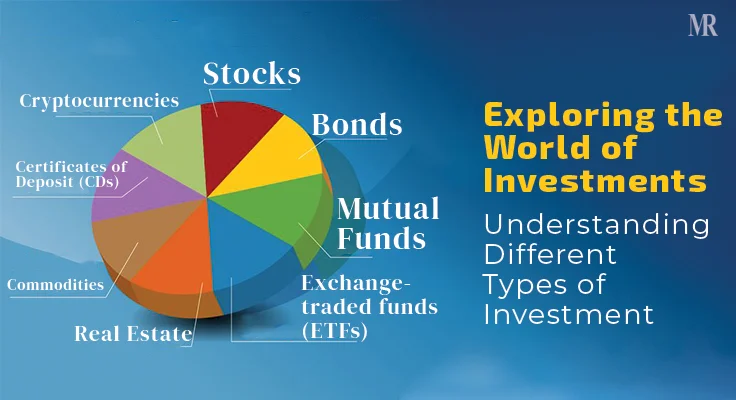Types of investment in the world
There are many types of investments in the world, each with its own characteristics in terms of risk, return and liquidity. Here are some popular types of investments:

1. Stocks
- Description: Buying shares of publicly traded companies.
- Benefits: High growth potential, dividend income.
- Risks: Market volatility, potential for capital loss.
2. Bonds
- Description: Lending money to governments or corporations in exchange for periodic interest payments.
- Benefits: Lower risk, steady income.
- Risks: Interest rate fluctuations, inflation risk.
3. Real Estate
- Description: Investing in property, either residential or commercial.
- Benefits: Potential for capital appreciation, rental income.
- Risks: Illiquidity, maintenance costs, market fluctuations.
4. Mutual Funds
- Description: Pooling money with other investors to buy a diversified portfolio of stocks, bonds, or other securities.
- Benefits: Professional management, diversification.
- Risks: Management fees, potential for lower returns than direct investment.
5. ETFs (Exchange-Traded Funds)
- Description: Investing in a fund that tracks a specific index, sector, commodity, or other assets and is traded like a stock.
- Benefits: Diversification, low fees, liquidity.
- Risks: Market risk, tracking errors.
6. Cryptocurrencies
- Description: Investing in digital currencies like Bitcoin, Ethereum.
- Benefits: High growth potential, innovative field.
- Risks: High volatility, regulatory uncertainty, security risks.
7. Gold and Precious Metals
- Types of investment in the worldTypes of investment in the worldDescription: Investing in physical gold, silver, or other precious metals or in securities backed by these commodities.
- Benefits: Hedge against inflation, safe haven asset.
- Risks: Price volatility, storage costs.
8. Private Equity
- Description: Investing in private companies or buyouts, typically through private equity funds.
- Benefits: High return potential, active involvement in business growth.
- Risks: High risk, illiquidity, high minimum investment.
9. Venture Capital
- Description: Providing capital to startups and small businesses with strong growth potential.
- Benefits: Potential for substantial returns, equity participation in early-stage companies.
- Risks: High risk of failure, long investment horizon, illiquidity.
10. Real Estate Investment Trusts (REITs)
- Description: Investing in companies that own, operate, or finance income-producing real estate.
- Benefits: Dividend income, diversification, liquidity.
- Risks: Market risk, interest rate risk.
11. Commodities
- Description: Investing in raw materials like oil, gas, agricultural products.
- Benefits: Diversification, hedge against inflation.
- Risks: High volatility, influenced by geopolitical events and supply-demand dynamics.
12. Savings Accounts and CDs
- Description: Depositing money in bank accounts or certificates of deposit with fixed interest rates.
- Benefits: Low risk, guaranteed returns, liquidity (for savings accounts).
- Risks: Low returns, inflation risk.
13. Foreign Exchange (Forex) Trading
- Description: Buying and selling currencies on the foreign exchange market.
- Benefits: High liquidity, 24/7 trading opportunities.
- Risks: High volatility, requires deep knowledge and good risk management.
14. Futures Contracts
- Description: Contracts to buy or sell an asset (such as commodities or indices) at a future date at a predetermined price.
- Benefits: High leverage, potential profits from price movements.
- Risks: High risk due to leverage, requires knowledge and experience.
15. Options
- Description: The right to buy or sell an underlying asset at a specific price before a certain date.
- Benefits: Maximizes profits with a small capital, hedging tool.
- Risks: Loss of the entire investment if the prediction is wrong.
16. Hedge Funds
- Description: Investment funds that use complex strategies to maximize returns.
- Benefits: High profit potential, professional management.
- Risks: High risk, high capital requirements, high management fees.
17. Startup Investment
- Description: Investing in startups with high growth potential.
- Benefits: High profit potential, opportunity to participate in innovative projects.
- Risks: High risk of failure, low liquidity.
18. Venture Capital
- Description: Providing capital to early-stage companies.
- Benefits: High profit potential, large equity ownership in the company.
- Risks: High risk of capital loss, long payback period.
19. Social Investing
- Description: Investing in social projects or companies with high social responsibility.
- Benefits: Contributing to the community, sustainable profits.
- Risks: Returns may be lower than traditional investments.
20. Derivatives
- Description: Financial instruments derived from the value of an underlying asset (stocks, bonds, commodities).
- Benefits: Hedging risk, profit opportunities from price movements.
- Risks: Complex and high risk, requires deep knowledge.
21. Investment in Agricultural Land
- Description: Buying land for farming or leasing.
- Benefits: Land value appreciation, income from agricultural products.
- Risks: Maintenance costs, weather risks.
22. Tech Investing
- Description: Investing in technology companies or new tech projects.
- Benefits: High growth potential, opportunity to participate in new trends.
- Risks: High stock price volatility, project failure risk.
23. Renewable Energy Investment
- Description: Investing in clean energy projects like solar and wind power.
- Benefits: Environmental protection, long-term growth potential.
- Risks: High initial investment costs, dependent on government support policies.
24. Government Bonds
- Description: Buying bonds issued by the government.
- Benefits: Safe, stable income.
- Risks: Low interest rates, inflation risk.
25. Investment in Education and Training
- Description: Investing in courses and training programs.
- Benefits: Enhances knowledge and skills, increases career opportunities.
- Risks: Investment costs, no immediate guarantee of success.
26. Commercial Real Estate Investment
- Description: Buying and leasing offices, shops, or industrial zones.
- Benefits: Stable rental income, property value appreciation.
- Risks: High maintenance costs, risk of vacancies.
27. Agricultural Commodities
- Description: Buying and selling agricultural products like wheat, corn, coffee.
- Benefits: Portfolio diversification, inflation hedge.
- Risks: Price volatility due to weather, supply and demand.
28. Structured Products
- Description: Complex financial instruments combining multiple types of assets.
- Benefits: Customized risk and return according to needs.
- Risks: Complex, high risk, high transaction costs.
29. Healthcare and Medical Investment
- Description: Investing in stocks, funds, or projects related to healthcare and pharmaceuticals.
- Benefits: High growth potential due to high healthcare demand.
- Risks: Legal risks, industry competition.
30. Emerging Markets Investment
- Description: Investing in emerging markets like Southeast Asia and Africa.
- Benefits: High profit potential, geographic diversification.
- Risks: Political risk, economic instability.
31. Investment in Digital Assets
- Description: Investing in digital assets such as NFTs, domain names, and digital content.
- Benefits: High growth potential, innovative field.
- Risks: High price volatility, unclear legal regulations.
32. Investment in Biotechnology Projects
- Description: Investing in companies or projects developing biotechnology.
- Benefits: Strong growth potential, high healthcare demand.
- Risks: High risk due to dependence on research and development, strict legal regulations.
33. Investment in Online Education (EdTech)
- Description: Investing in companies providing online education services.
- Benefits: Increasing demand for online learning, significant growth potential.
- Risks: High competition, requires quality technology and content.
34. Investment in Sports and Entertainment
- Description: Investing in sports teams, entertainment events, or entertainment companies.
- Benefits: Booming entertainment industry, high profits.
- Risks: Dependent on consumer preferences, fierce competition.
35. Investment in Digital Health
- Description: Investing in companies providing digital health services, such as telemedicine and health apps.
- Benefits: Large growth potential, rising demand for digital health.
- Risks: High competition, risks related to security and personal data.
36. Investment in International Real Estate
- Description: Purchasing real estate in other countries to diversify investment portfolios.
- Benefits: Profits from international real estate appreciation, rental income.
- Risks: Legal, political, and economic risks in the investment country.
37. Investment in Hedge Funds
- Description: Investing in hedge funds that use complex investment strategies to maximize returns.
- Benefits: High returns, professional management.
- Risks: High risk, high management and transaction fees.
38. Investment in Energy Projects
- Description: Investing in energy projects such as wind power, solar power, and nuclear energy.
- Benefits: Long-term growth potential, contribution to environmental protection.
- Risks: Technological risks, high initial investment costs, dependent on government support policies.
39. Investment in Resort Real Estate
- Description: Purchasing real estate in resorts to rent out or use.
- Benefits: Rental income, potential increase in real estate value.
- Risks: Low liquidity, dependent on the tourism industry.
40. Investment in Art
- Description: Purchasing and collecting artworks.
- Benefits: Value appreciation over time, personal enjoyment.
- Risks: Low liquidity, value dependent on tastes and trends.
41. Investment in Wine and Spirits
- Description: Purchasing and storing fine wines or premium spirits.
- Benefits: Value appreciation over time, personal enjoyment.
- Risks: Requires good storage conditions, limited market.
42. Investment in Farmland
- Description: Purchasing and operating agricultural land.
- Benefits: Income from crops, potential land value appreciation.
- Risks: Weather risks, maintenance costs.
43. Investment in Medical Devices
- Description: Investing in companies developing and manufacturing medical devices.
- Benefits: High healthcare demand, significant growth potential.
- Risks: Strict legal regulations, industry competition.
44. Investment in Green Energy
- Description: Investing in green energy projects such as solar power and wind power.
- Benefits: Environmental protection, long-term growth potential.
- Risks: High initial investment costs, technological risks.
45. Investment in Aviation
- Description: Investing in airlines, airports, or aircraft.
- Benefits: Growing aviation industry, high profits.
- Risks: Economic risks, fuel price volatility, strict regulations.
46. Investment in Information Technology
- Description: Investing in companies or projects related to information technology.
- Benefits: Rapidly growing IT industry, high returns.
- Risks: High competition, market volatility.
47. Investment in Pharmaceuticals
- Description: Investing in companies producing drugs and pharmaceuticals.
- Benefits: High healthcare demand, significant growth potential.
- Risks: Strict legal regulations, industry competition.
48. Investment in Private Education
- Description: Investing in private schools and educational institutions.
- Benefits: Increasing demand for education, stable profits.
- Risks: High competition, dependent on the quality of education.
49. Investment in Water Resources
- Description: Investing in water supply and management projects.
- Benefits: Increasing water demand, long-term growth potential.
- Risks: High investment costs, resource management risks.
50. Investment in Charitable Funds
- Description: Investing in charitable funds to support social projects.
- Benefits: Community contributions, tax benefits.
- Risks: Low financial returns, dependent on charitable goals.
These investment types offer diverse options for investors, suitable for different goals and risk tolerance. Choosing the right type of investment should be based on careful analysis and advice from financial experts.
